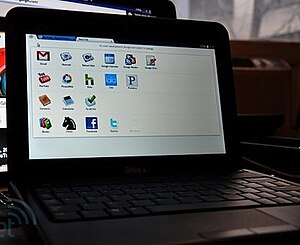If you haven’t heard of Chrome OS, it’s Google’s attempt to do away with the desktop altogether and have everything that happens on your computer happen inside the browser. This means that instead of opening Outlook for your email, you go to Gmail or Hotmail on the web. Instead of opening Photoshop to resize that photo, you use Aviary.com. Instead of desktop apps, you switch to web apps. After Google’s recent announcement that schools would be able to lease Chromebooks for $20/student/month, educators have been wondering if they could depend on a laptop that doesn’t come with its own desktop, has the internal storage of a mid-range smartphone, and only works when it’s connected to the Internet.
Yaysaying
Some people are excited at the prospects of moving completely into the cloud and leaving expensive, slow desktop computers behind. After all, Educause has been warning us since 2009 that cloud computing was on the horizon. Chromebooks boot up instantly, run lightning fast, and cost less than half of what you can expect to pay for a Macbook. It truly is possible to keep up with most common computing tasks using only web-based apps. For the Chromebook to exist, there has to be a full suite of web apps that enable you to do most common computing tasks in a browser with no (or few) compromises. That suite of apps exists. Email, office docs, audio creation, image manipulation, vector drawing, video editing, productivity apps, social media– all of these can happen in a browser now. Don’t believe me? Type your favorite piece of desktop software into Alternativeto.net and find the many cloud alternatives that can take its place. For free. In a browser. If you’re the type of person who spends most of your time in a browser, these devices might be perfect for you. If you’re not, you probably fall into the next category….
Naysaying
Others think that we are simply not ready to cut our ties to the trusty desktop and plant our feet firmly in the Cloud. A netbook minus the ‘net is not much of anything at all, IMHO. If you often find yourself outside the reach of WiFi or 3G data connections (which many of us often do) then you know just how important it is to be able to work offline. If you depend on a certain piece of software that only comes on your chosen OS, you might be loath to leave it behind for a cloud alternative. Add this to the increased responsiveness and power of desktop apps over webapps (we’re seeing people’s clear preference for apps in the world of smartphones) and the wealth of free and open source desktop applications available and it feels premature to kiss our old friend the Desktop goodbye.
The Way Forward
I think the best thing about Chrome OS is that you don’t have to actually use it to get the benefits it offers– you can choose to go “all webapps” in whichever OS you happen to prefer. This fact also means that you don’t need a CR-48…. you can still get a Mac, Windows, or Linux computer (or build your own!), install Chrome browser, and enjoy all of the pleasures that Chrome offers PLUS the offline desktop apps you love and depend on. I’ve long been a proponent of software that has online/offline syncing capabilities like my beloved Evernote, the amazing Dropbox, or the venerable Thunderbird email from Mozilla. I’ve also been patiently waiting for a day when I could get a powerful laptop for under $400 that does everything I want it to do. The fact that Google has been working so hard to bring us a computing experience that doesn’t depend on the OS you’re running means that these dreams are becoming a reality.
Now, you can get a cheap, powerful laptop computer, install the free open source Ubuntu Linux OS on it (to get all the goodies that a true desktop OS with real apps brings), and then run all the webapps I want– right there in the browser. The fact that we have viable choices on the desktop and the cloud changes the conversation from an “either/or” to an “also/and”.
For schools trying to offer a high quality- modern computing experience to students on a budget, this represents a viable vision of how to make that happen.
Related articles
- Chrome OS Launches in June, Only on Notebooks (pamil-visions.net)
- How to install Google’s Chrome OS (zdnet.com)
- Meet The New Chromebooks (appreaders.com)
- So.. Chrome OS has no Desktop? (thechromesource.com)
- Chromebooks Take Us Closest So Far to a Post-PC Era (customerthink.com)
- Will the Google Chromebook Replace Your Laptop? (pcworld.com)
- Google Chromebook, Do You Consider Buying One? (ghacks.net)
- Google Chrome OS: Too secure to need security? (go.theregister.com)
Liked this post? Follow this blog to get more.



